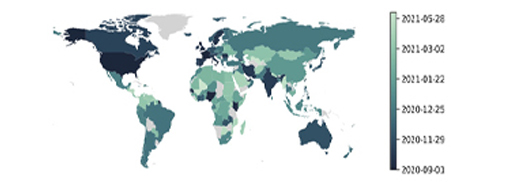2.2 Origin and spread of variants
New VOCs are usually first identified in the country where they originated. However this depends on the availability of good genomic sequencing facilities and a programme of surveillance. For example, the gamma variant was first identified in Tokyo on Jan. 6th 2021, in 4 travellers arriving from Brazil. Presence of the variant was confirmed in Brazil on Jan. 12th 2021 and retrospective analysis of samples implied that it had been circulating widely in Manaus (Brazil) since December 2020.
It is effectively impossible to identify exactly where and who was the first person to develop a new VOC. Variants are most likely to arise where large numbers of people are infected, but this is merely based on probability. Also it has been conjectured that variants are more likely to occur in people who have extended infections, possibly because they have a weak immune response. The delay in clearance of the virus in an immunosuppressed individual could allow the virus more time and opportunity for advantageous mutations to emerge.
It is interesting to note that it was 1 year (2020) before the first VOC (alpha) emerged, and in this year the number of infections was relatively low, so there was less opportunity for variants to develop, and there was less selective pressure on the virus from immunity in the host population. Several VOCs emerged in 2021 and 2022 as more people became infected.
The rate of spread of pandemic strains of disease has historically been dependent on the fastest form of transport available. For many previous centuries this has been ships and the original term quarantine refers to the isolation of ships carrying (or potentially carrying) infected individuals, for 40 days. More recently, air transport has been the means for the rapid spread of new strains of viruses, including influenza-A, SARS, MERS and SARS-CoV2.
Data on the alpha variant shows how it initially spread in Western Europe and North America with later spread to Asia, South America and Africa (Figure 4). There are however some exceptions such as the early identification of the variant in India. This may reflect the travel links that these countries have with the UK, and it may also relate to the effectiveness of their genomic surveillance programmes.

